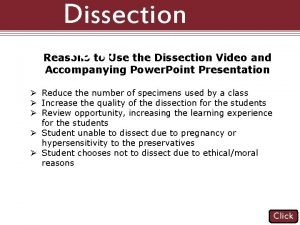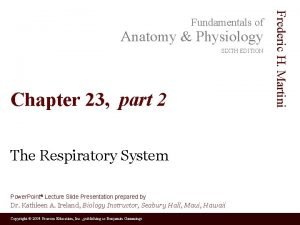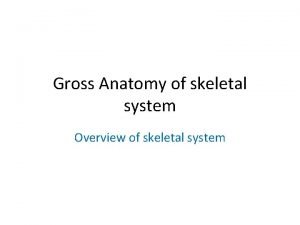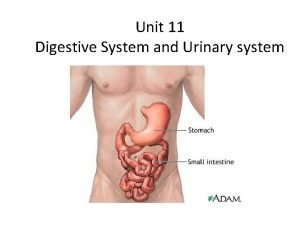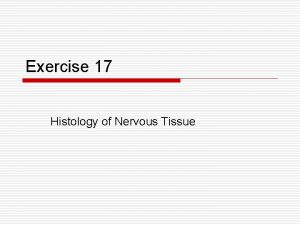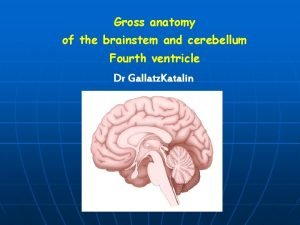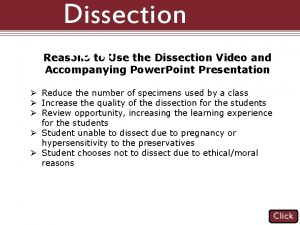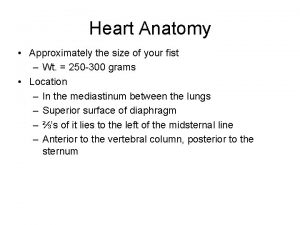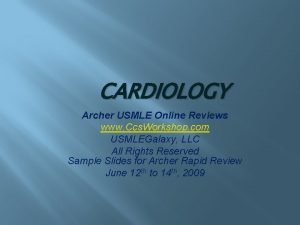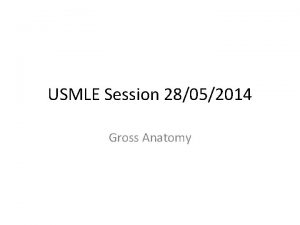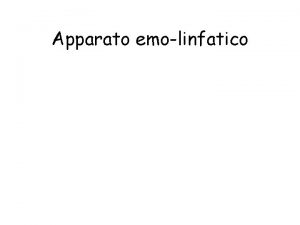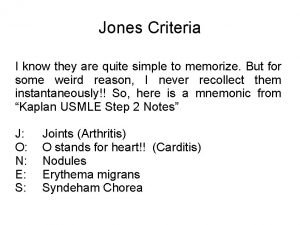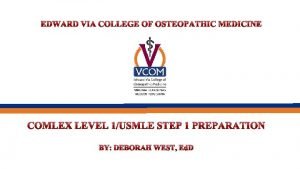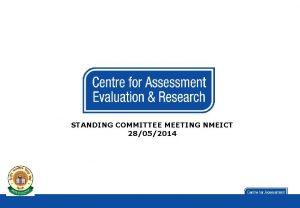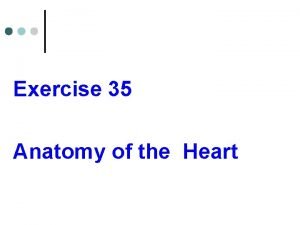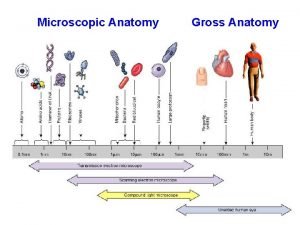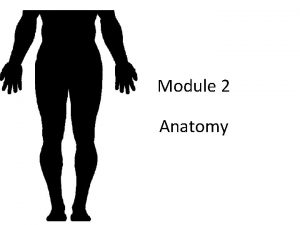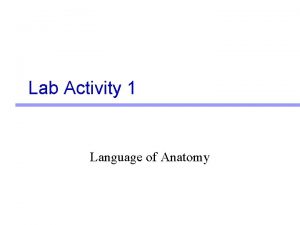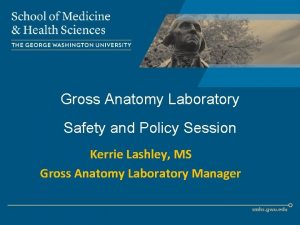USMLE Session 28052014 Gross Anatomy A 35 yearoldfemale



























- Slides: 27

USMLE Session 28/05/2014 Gross Anatomy

A 35 year-old-female presents to her gynecologist after missing her period for the past 3 months. She is sexually active and uses condoms for contraception but has not had a sexual partner in the last year. She also reports that her breasts have been leaking milk for some time. Physical examination is normal. A head MRI is shown. Which of the following structures would most likely be jeopardized if the tumor continues to increase in size? a. Optic chiasm b. Fourth ventricle c. Cerebral aqueduct d. Thalamus e. Caudate nucleus



correct answer: A Prolactinomas are prolactin-secreting tumors of the anterior pituitary, classically presenting with galactorrhea and amenorrhea or infertility in pre-menopausal women. Amenorrhea occurs due to prolactin’s inhibition of LH, as well as Gn. RH pulses. Downregulation of Gn. RH leads to a decrease in FSH, and subsequently, estrogen levels leading to anovulation. Fortunately, these effects lead to their early detection in premenopausal women compared to their male and post-menopausal counterparts. In the latter populations these tumors tend to be of greater size and do not come into clinical attention until they are large enough to affect adjacent structures. The optic chiasm (Option A) is located directly above the pituitary gland can be compressed leading to blindness. None of the remaining options are near the pituitary gland therefore are less likely to be affected by these tumors.

A 27 year-old woman is brought to the emergency room by ambulance after a car accident. She is complaining of a severe headache and is somewhat disoriented. Her heart rate is 110 and her blood pressure is 134/72. She has several abrasions of her face with some swelling and ecchymosis. She has a dark ecchymosis over her right mastoid process. CT scan of the head shows an intracranial hemorrhage that does not cross suture lines. The anatomic structure that passes through which of the following foramina has most likely been damaged? a. Carotid canal b. Foramen magnum c. Foramen rotundum d. Foramen spinosum e. Optic canal



correct answer: D This patient has a basilar skull fracture secondary to trauma sustained in a car accident. Battle's sign, ecchymosis over the mastoid process, is consistent with a basilar skull fracture. Also, this patient has an epidural hemorrhage as seen on CT scan (does not cross suture lines). This scenario is due to rupture of the middle meningeal artery, which passes through the foramen spinosum. The maxillary nerve (V 2) passes through the foramen rotundum. The optic nerve and ophthalmic artery passes through the optic canal. The internal carotid artery passes through the carotid canal. The brainstem (specifically, the medulla), meninges, vertebral arteries, and the spinal roots of the accessory nerve all pass through the foramen magnum.

A 12 -year-old boy is brought to the physician by his father because of redness and swelling of his left foot for 24 hours. Three days ago, the boy scraped his foot while wading in a drainage ditch. Examination of the left foot shows a purulent abrasion with edema, erythema, and tenderness on the lateral side. Infection is most likely to next spread from the lateral side of the foot to the regional lymph nodes in which of the following areas? a. Lateral surface of the thigh b. Medial malleolus, posteriorly c. Popliteal fossa d. Sole of the foot e. Superficial inguinal area

correct answer: C The boy's wound appears to be superficial - he "scraped" his foot which is now infected (likely by a Gram positive organism such as Strep A or Staph). The superficial lymphatic drainage of the lower extremity roughly follows the superficial vessels. In this case of the lateral foot, the lymphatics drain along the path of the small saphenous vein to the popliteal fossa.

A 25 -year-old woman is undergoing a nephrectomy in order to donate her kidney to her older sister, who has renal failure. The surgeon accidentally cuts a vein draining into the inferior aspect of the renal vein on the side of the kidney which is to be removed. What is the most likely identity of this vein? a. Left ovarian vein b. Left suprarenal vein c. Right ovarian vein d. Right suprarenal vein e. Splenic vein


correct answer: A The left ovarian vein (or testicular vein in men) enters the inferior aspect of the left renal vein. The left suprarenal vein (B) also enters the left renal vein, but at its superior aspect. The right ovarian (C) and right suprarenal (D) veins drain directly into the inferior vena cava. The splenic vein (E) joins with the superior mesenteric vein to form the portal vein. Of note, in kidney transplantation, the left kidney is usually preferred because the left renal vein is longer than the right renal vein (the left renal vein has to cross over the vertebral column to get to the inferior vena cava while the right does not).

A 17 -year-old male falls on his wrist while playing basketball. After taking a history, you notice on physical exam that he has marked tenderness within the "anatomical snuff box. " What is the likely diagnosis? a. Fracture of the hook of the hamate bone b. Fracture of the pisiform bone c. Fracture of the scaphoid bone d. Tendonitis e. Wrist sprain


correct answer: C The anatomical snuff box is the triangular space formed by the extensor pollicis longus (medial border), extensor pollicis brevis & abductor pollicis longus (lateral border), and the distal radial styloid. The trapezium and scaphoid bones form the floor or base of the snuff box. Tenderness in the anatomical snuffbox indicates scaphoid fracture until proven otherwise!

A 19 -year-old construction worker sustains a superficial laceration of the anterior wrist just proximal to thenar and hypothenar eminences. Sensation is intact. Which of these tendons has most likely been severed? a. Extensor carpi ulnaris b. Flexor digitorum profundus c. Flexor digitorum superficialis d. Flexor pollicis longus e. Palmaris longus


correct answer: E The most superficial of the above tendons is the palmaris longus (E). The extensor carpi ulnaris (A) is not on the anterior wrist. The flexor digitorum profundus (B), flexor digitorum superficialis (C), and flexor pollicis longus (D) tendons are all in the carpal tunnel, and are thus covered by the flexor retinaculum, whereas the palmaris longus is not.

A 40 -year-old woman is diagnosed with a lesion of the facial nerve proximal to the origin of the chorda tympani in the posterior wall of the tympanic cavity. Which of the following functions would most likely remain intact in this patient? a. Control of muscles in lower half of face b. Control of muscles in upper half of face c. Salivary secretion by submandibular gland d. Taste sensation from anterior two-thirds of tongue e. Tear production by lacrimal gland


correct answer: E Choice E (Tear production by lacrimal gland) is correct. The greater petrosal nerve branches from the facial nerve at the level of the geniculate ganglion. It is the source of preganglionic parasympathetic nerve fibers for the lacrimal gland. Choice A (control of muscles in lower half of face) and Choice B (control of muscles in upper half of face) are incorrect. A lesion of the facial nerve proximal to its terminal branches (the temporal, zygomatic, buccal, marginal mandibular, and cervical nerves) would result in paralysis of all ipsilateral muscles of facial expression. Choice C (salivary secretion by submandibular gland) and Choice D (taste sensation from anterior two-thirds of tongue) are incorrect. The chorda tympani carries taste from the anterior two-thirds of the tongue and preganglionic parasympathetic nerve fibers for the submandibular gland. Therefore, a lesion superior (proximal) to its branching point would result in loss of these functions.

A 60 -year-old man develops a tremor in his fingers. The tremor is most pronounced when he reaches for his coffee cup or points to an object. Which of the following components of the motor system is most likely to be involved? a. Basal ganglia b. Cerebellar hemisphere c. Cerebellar vermis d. Frontal eye field e. Motor nucleus of the thalamus


correct answer: B The tremor described in the question stem is an intention tremor since it is most obvious as the patient's hand moves closer to his target (i. e. his coffee cup), and is not present while at rest. Intention tremors are common in essential tremor, intoxication, multiple sclerosis. They are a sign of cerebellar dysfunction. The cerebellum is split into the vermis and hemispheres. The cerebellar hemisphere (B) regulates the coordination of the ipsilateral extremities and therefore would be involved in an intention tremor. The cerebellar vermis (C) regulates the trunk and midline structures and its dysfunction would cause ataxia (balance problems). Basal ganglia (A) involvement would cause rest tremor like those seen in Parkinson's. Frontal eye field (D) would cause vision problems but not a tremor. Motor nucleus of the thalamus (E) would most likely cause strength deficits, but not a tremor.

resources • • • http: //www. neurosurgery. medsch. ucla. edu/body. cfm? id=1123&ref=86&action=d etail http: //en. wikipedia. org/wiki/File: Gray 722 -svg. svg http: //doctorsgates. blogspot. cz/2010/12/photos-for-battle-sign. html http: //www. studyblue. com/notes/note/n/an 3 -03 -scalp-cranial-cavity-andface/deck/7019758 http: //contemporaryobgyn. modernmedicine. com/contemporaryobgyn/news/modernmedicine/modern-medicine-now/pelvic-phlebologyunderappreciated-emergi http: //www. yoganatomy. com/2014/03/wrist-pain-in-yoga/ http: //www. handcarecenter. com/scaphoid. html http: //medical-dictionary. thefreedictionary. com/palmaris+longus http: //classconnection. s 3. amazonaws. com/33/flashcards/602033/jpg/cn_vii__chorda_tympani_taste_(edit)1316910936377. jpg http: //www. tremorjournal. org/index. php/tremor/article/view/175/html-12
 Apa itu npv
Apa itu npv Cow eye vitreous humor
Cow eye vitreous humor Gross anatomy of the lungs
Gross anatomy of the lungs Gross anatomy of skeletal system
Gross anatomy of skeletal system Gastric gland
Gastric gland Colon gross anatomy
Colon gross anatomy Gross anatomy of a long bone
Gross anatomy of a long bone Exercise 17 gross anatomy of the brain and cranial nerves
Exercise 17 gross anatomy of the brain and cranial nerves Brainstem gross anatomy
Brainstem gross anatomy Cow eye optic nerve
Cow eye optic nerve Gross anatomy of heart
Gross anatomy of heart Chiari malformation usmle
Chiari malformation usmle Archer usmle
Archer usmle Cushing reflex usmle
Cushing reflex usmle Essential tremor vs intention tremor usmle
Essential tremor vs intention tremor usmle Bulimia vs anorexia usmle
Bulimia vs anorexia usmle Hereditary spherocytosis usmle
Hereditary spherocytosis usmle Usmle wiz
Usmle wiz Accommodation personal statement examples
Accommodation personal statement examples Rabbit antithymocyte globulin usmle
Rabbit antithymocyte globulin usmle Biostats usmle
Biostats usmle Hypocholermia
Hypocholermia Sindrome di sezary e micosi fungoide usmle a confronto
Sindrome di sezary e micosi fungoide usmle a confronto Jones criteria sketchy
Jones criteria sketchy Usmle step 1 tips
Usmle step 1 tips Pprom usmle
Pprom usmle Klein waardenburg syndrome usmle
Klein waardenburg syndrome usmle Nbomes definition
Nbomes definition

